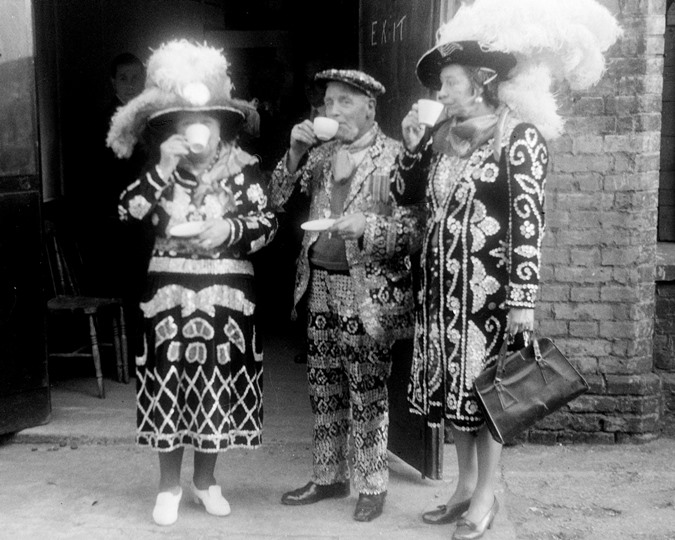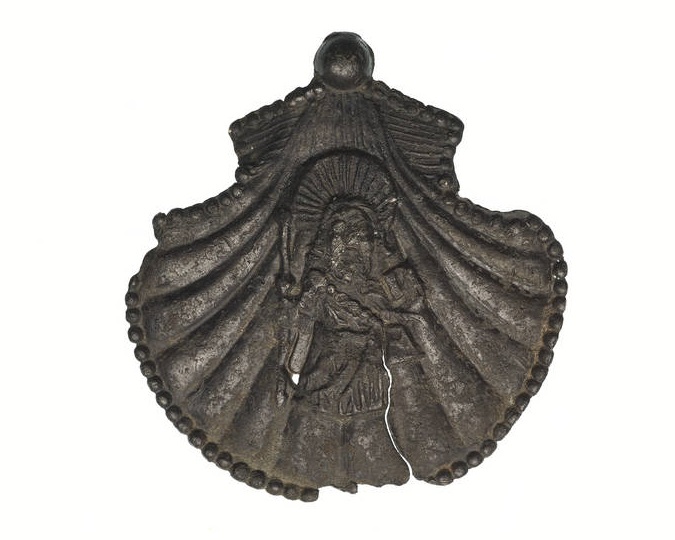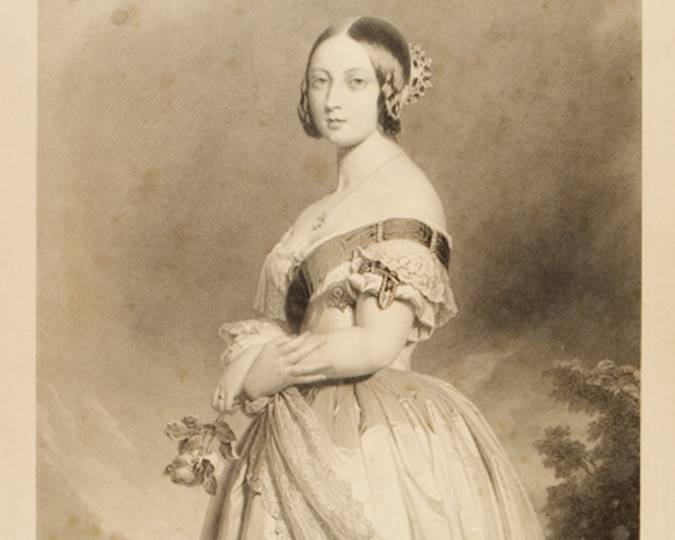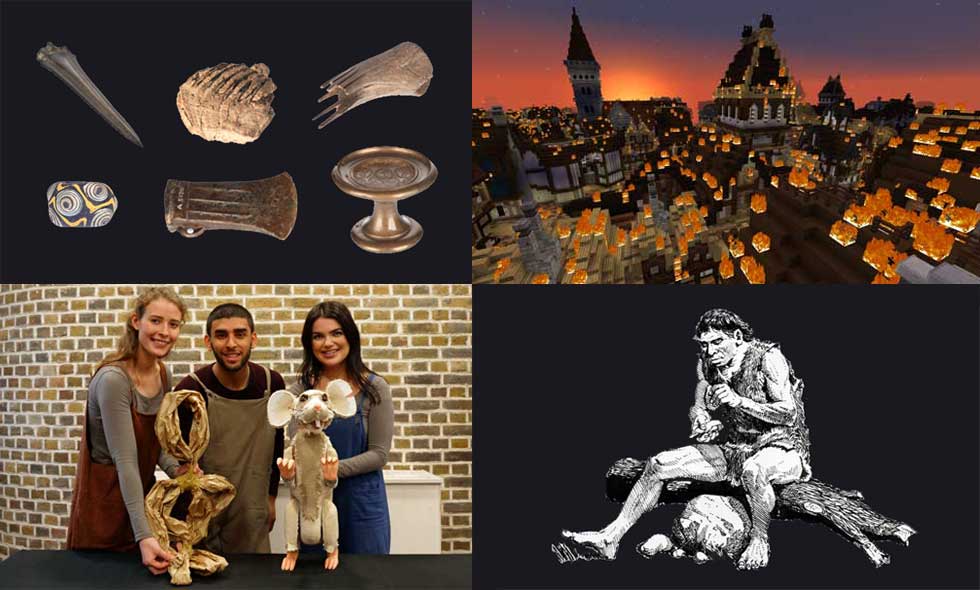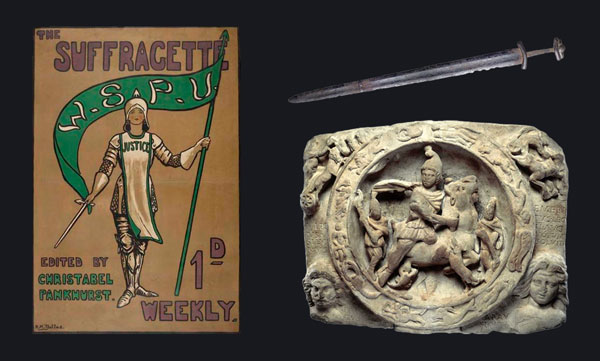Great Fire of London live stream: Part 3 - Full transcript
Get the transcript of our popular Great Fire of London live stream! Part 3 explores how the city was rebuilt and the fire changed London.
[Stream begins]
[00:01:09]
Marina:
Hello and welcome to this live stream from the Museum of London! Hopefully we have loads of schools and families joining us again today. Whether you're back for the third time or joining us for the very first time, I'd like to give you a very warm welcome!
My name is Marina and I’ll be your host for today, and joining us we have Meriel Jeater, and Meriel is a curator at the museum and our expert on the Great Fire!
[00:01:37]
Meriel:
Hello everyone!
[00:01:39]
Marina:
Before we get started, we have just a few important things to remind you of again:
Firstly, our Great Fire live streams are totally free and we never ask for card details to watch. Please do not enter your card details at any point if asked.
Secondly, we're streaming from our homes again, and there have been a few technical hiccups in the last couple of weeks, so a huge thank you for bearing with us!
[00:02:05]
Please make sure you have an adult with you during the stream, and encourage them to get involved too! And if you are watching on Facebook, please make sure that your profile is set to your preferred privacy settings before you comment. If you do comment on the stream, remember that the message and account name you use will be visible to the public. While we aren’t responsible for what is said in the comments, we encourage you to be sensitive to others.
Now adults, it’s up to you to type in the questions and remember not to share any personal details with us, including children’s first names or photos of them. So, we hope you can see and hear us clearly. Just give us a like or say hello on Facebook to let us know it’s all working today!
[00:02:52]
Now today is the last of our 3-part series looking at the Great Fire of London from 1666. It's especially for children studying it at Key Stage 1, but we hope that everyone will enjoy it. Today, we'll finish your tour through a past exhibition of ours called Fire! Fire!, and there will be more actions and activities for you to do together.
[00:03:15]
Before we tell you about today’s theme though, we just wanted to say a huge thank you to everyone who sent in their pictures and photographs of what is precious to them. We were so impressed with what came in, and we’ll be showcasing some of them at the end of today’s stream!
Now, the theme for your tour today is: how did the fire change people’s lives, and the city itself?
[00:03:42]
Meriel:
After your tour we’ll give you a couple of minutes to talk to each other about what you’ve seen and heard, and share any questions you have about it via comments on Facebook. And I’ll answer some of your questions live!
Now if we’re lucky, we’ll get lots of great questions and I’m aware I won’t be able to answer them all face-to-face. But we’ll do our best to reply to you in the comments on Facebook afterwards. And, if you’re really keen, and are looking for something fun to do afterwards, we’ll even suggest an exciting activity for you to do at the end.
[00:04:12]
Marina:
So, what are we waiting for? Are you ready to finish your tour? Then let’s get started! My colleague Nina is back to show you around for the last time.
[00:04:31]
Nina:
So, what happened when the fire was finally put out?
Meriel:
Well, this was the scene on Thursday the 6th of September when the fire was out. Just a sea of rubble with piles of debris, with spires of churches and chimneys sticking out of the rubble. When people walked through the ruins they got lost. They couldn’t find where their house used to be. And in fact this whole area became very dangerous. If you walked through it at night, you might get robbed.
[00:04:58]
Nina:
I wonder, did people find any belongings left in among the ruins?
Meriel:
Well, actually today we find things that people left behind. So, when archaeologists dig up bits of London they sometimes find the belongings of, you know, burnt remains and we’ve got some on display actually in the exhibition if you’d like to see.
[00:05:19]
These metal objects were found by archaeologists on the site of a house that had been destroyed in the Great Fire. They’ve been damaged by the heat and then they’ve got really rusty. So, it was really hard for the archaeologists to work out what they were. So, they had to X-ray them to see the objects underneath the layers of rust. Just like if you break your arm, the doctors have to X-ray your arm to see the bones underneath your skin.
Nina:
Yes, of course. Before we reveal the X-rays, just see if you can work out what the rusty object is.
[00:05:50]
What is this object?
[15 second countdown timer begins]
[00:06:07]
Meriel:
If you press the X-ray.
Nina:
Oh right!
Meriel:
You see it’s a padlock.
Nina:
Yes.
Meriel:
And then this object here, which looks like just a lump of rust.
[00:06:19]
What is this object?
[15 second countdown timer begins]
[00:06:34]
Meriel:
Press the X-ray and it’s a key.
Nina:
Oh you can see it’s a key, yes.
Meriel:
And then there’s a really interesting object down here, which looks like a rusty square.
[00:06:47]
What is this object?
[15 second countdown timer begins]
[00:07:03]
Meriel:
Press the X-ray and it’s a waffle maker.
Nina:
Oh, I didn’t know they had waffle makers!
Meriel:
I know, it’s an amazing thing to survive.
Nina:
Oh, what a lovely object.
Meriel:
And it’s very heavy, so I can see why somebody would have left it behind when they were escaping from the fire.
[00:07:19]
Nina:
Yes. So, what happened to all these poor, homeless Londoners?
Meriel:
Well, I can show you over here.
[00:07:27]
Meriel:
Over 13,000 houses burnt down, so about 100,000 people lost their homes.
Nina:
100,000 people and what happened to them all? Where did they go?
Meriel:
Well, thousands of people camped in the fields outside of London. And some people lived there for up to eight years in sheds that they built.
[00:07:44]
Nina: I want you just to shut your eyes for a moment. If you’ve got space you might want to lie down or lean against a friend and just imagine sleeping in the fields. Imagine what it was like for the people that were made homeless. And listen to this eyewitness account of people’s experiences.
[00:08:05]
‘The poor inhabitants were dispersed all about St George’s, Moorfields, as far as Highgate and several miles around. Some were in tents, others under miserable huts and hovels, without a rag to wear or any necessities. Those who had lived in luxury and riches, were now reduced to extreme misery and poverty.’
[00:08:31]
Nina:
So, all people were affected, rich and poor. Now they were just sleeping side by side.
Meriel:
Yes, and the king realised that some people had lost everything in the fire, so he set up a special fund and people from around the country sent money to London to help.
[00:08:46]
Nina:
I suppose just like today, we raise money for charity, don’t we? In fact, perhaps you remember a time when your school has raised money for charity.
Meriel:
And what people did here, and this is a little document, and it’s from the village of Cowfold in Sussex, and it says that they donated 53 shillings and 9 pence to the Fire Relief Fund, which is about £400 in today’s money. So they were really generous.
Nina:
Oh, that’s really nice from a little village.
[00:09:15]
Meriel:
So if you wanted some money from the fund, you could write a letter to the Lord Mayor explaining how the Great Fire had made you really poor and he would give you some money from the fund.
Nina:
Right. And what about the rebuilding of the city itself?
Meriel:
Well, if you come this way I can show you more about that.
[00:09:31]
After the fire lots of people had different ideas and how to rebuild the city to try and get rid of all the old problems of crowded streets where fires could happen. So, they suggested building long wide roads. But actually, it would have been too expensive to do that. The quickest way really to rebuild London was to let people build their houses on the same place they had before. If you look at these two maps - one is from before the fire and one is from after - the street layout is almost exactly the same.
[00:10:05]
Nina:
Oh yes…
Meriel:
Though the layout of London didn’t change much after the fire, the way London looked changed. Because the fire got rid of all the old wooden buildings.
Nina:
Alright, so there were rules for how things could be built?
[00:10:21]
Meriel:
Yes, yes I can show you. So here we can see the new houses have to be built from brick.
Nina:
Oh yes.
Meriel:
And if you build a wooden house, then it will be pulled down. Houses are no longer allowed to lean out into the street the way they did before. You have to have a straight house. If you live in an important streets, you can have a four story house.
Nina:
Oh nice. The sort of house we see in London today.
Meriel:
Yes. Or if you live in a very small street, you can have a smaller two story house like this one.
[00:11:01]
Nina:
Well, thank you for joining us for this walk around the ‘Fire! Fire!’ exhibition at the Museum of London. And thank you to Meriel for showing us around.
Meriel:
A pleasure.
[00:11:20]
Marina:
Well, we hope you enjoyed your last instalment of our Fire! Fire! Exhibition. Well done if you guessed the objects as well. Now it’s your chance now to have a good think and talk amongst yourselves about what you’ve seen and heard. Share any questions that you might have for Meriel on the Facebook comments.
Meriel:
I can’t wait to see your questions!
[00:11:40]
Marina:
Remember not to give us any children’s first names, but if you’re in school, let us know your school and class name. And remember, focus on what we’re learning today – how the fire changed the city. You’ve got 3 minutes to think and share your questions… Go!
[Three minute countdown clock begins]
[00:15:07]
And welcome back! We’ve had some fantastic questions come in yet again! So, without further ado, let’s get answering them...
[00:15:16]
So our first question came in from Chat and they say, ‘Did they have any kind of fire alarms back then?’
Meriel:
Well, I think if you saw a fire in your local area, you were meant to raise the alarm. So, you know, shout to your neighbours to wake up or you know, help or things like that or fire!
So, that was the fire alarm. Oh and they used to ring church bells as well during times of emergency.
Marina:
Ok, so kind of reliant on other people to sound the alarm then.
Meriel:
Yes, there was no actual, electrical fire alarm at the time.
[00:15:55]
Marina:
Ok. Our next question is from Clari. They say, ‘How many people died during the fire?’
Meriel:
That’s a really interesting question because we actually don’t really know. Because all the records that would normally record when people died and what from and so on, they got very disrupted because of all the chaos around the Great Fire, so the records haven’t really survived.
But there’s about six people who are listed as dying by being burnt, in the kind of, the records and then a few people so it’s fewer than then but it may be more, we’re just not sure.
[00:16:37]
Marina:
And was one of those in the bakery where the fire started?
Meriel:
Yes, the first person we think to die from the Great Fire was a maid who lived in the bakery and she… the family escaped out of the window but she was too frightened because it was high up and she stayed in the house.
Marina:
How terrible.
Meriel:
Yeah, really sad.
[00:16:58]
Marina:
Our next question is from Katherine and it’s actually about, ‘What signs are there of the fire, that still exist today?’
Meriel:
In terms of if you were to walk round the City of London, would you see any old scorched buildings, no you wouldn’t. But archaeologists do when they’re digging in the City of London. If they’re digging in an area that was burnt in the Great Fire, they will often dig down through a layer of burnt sort of soil and burnt melted things which they call ‘the fire horizon’. So it’s still possible to find evidence of the Great Fire if you dig, but not necessarily just around the city, you know everyday.
[00:17:40]
Marina:
And does that layer help archaeologists to date the layers?
[00:17:45]
Meriel:
Yes, so you know because we know the fire definitely happened in 1666, if you find that layer, you know, ‘Ah, that’s the date of that,’ so everything that we find underneath that is going to be older, so actually it’s quite useful for our archaeologists.
Marina:
Really interesting, thank you Meriel!
[00:18:04]
Marina:
We have a few questions from schools coming in. So, Broomgrove Junior School in Essex have asked, ‘How many years did it take to rebuild the houses?’
[00:18:15]
Meriel:
Well, most houses were rebuilt within about ten years of the fire, though some of them took longer to rebuild than that. So actually the place where the fire started, the bakery, that area was left empty until 1680, so that’s 14 years after the fire and then someone built their house on top of it. So it does take a while, yes.
[00:18:40]
Marina:
Sounds like it depends where it was as well.
Meriel:
Exactly. Yeah but most people’s homes were rebuilt within ten years.
[00:18:48]
Marina:
And Carly has asked a related question, ‘Who cleared away the rubble and the debris?’
Meriel:
I think it was supposed to be the householders themselves, who were supposed to clear away the rubble, but in practice people didn’t. I guess it was such a huge task so not enough rubble was cleared. So, I have a feeling, though I would need to check, I have a feeling the City of London actually paid people to move the rubble away. What they did was they pushed it into cellars and things like that to sort of flatten off the ground and then they built on top.
Marina:
Oh that’s interesting, wow! Great question there Carly, thank you.
[00:19:27]
Marina:
We have from Claire, ‘What did the homeless do for toilets and food when they were sleeping in the fields?’
[00:19:36]
Meriel:
Oh, well the toilets… there were some bushes and trees and fields around London. There were some sort of ditches and things like that too so I think probably, people had to sort of... improvise.
In terms of food, they set up temporary markets around London where people could go and buy food. I think probably facilities got a bit more organised later on because they had whole streets with lots of temporary housing that people had built out of pieces of wood and things like that which were outside the city for quite a few years, so I’m sure people would have built themselves cesspits and things for their temporary houses, which is where you go to the toilet.
Marina:
All very innovative, having to improvise!
[00:20:28]
Marina:
I’ve seen that we have a few questions from Violet Class from Monkfield School. They’ve asked lots of wonderful questions and I know that they’ve joined us every week, so hello Monkfield School!
Meriel:
Hello!
[00:20:39]
Marina:
Our question is, ‘How long after did they find the objects which we saw in the show? That we saw in the video?’
[00:20:48]
Meriel:
Ok, so the objects that we saw with the X-rays, they were excavated in 1995. So, my maths escapes me but that’s about 300 and something years after the Great Fire.
Marina:
Wow, so they are relatively recent finds!
Meriel:
Yeah, yeah not very long ago.
[00:21:11]
Marina:
A kind of related question, we talked about Samuel Pepys last week, ‘How many years later was Samuel Pepys’ diary recovered?’
Meriel:
Well, he left his diary and a lot of his books and other belongings to Magdalene College, Cambridge in his will. So when he died, all of his things, not all of his things but his diary and other things went to that college in Cambridge. And I think it was in their library for many, many years and it’s not allowed to leave them, they have to keep it, yep!
Marina:
Well that’s interesting. Thank you Meriel! Some great questions from Monkfield School there.
[00:21:53]
Marina:
Now we have Vicky’s question, ‘Were houses and belongings insured before the Great Fire happened?’
[00:22:03]
Meriel:
They weren’t, no. Insurance existed for things like ships but for people's houses and belongings it didn’t. So if all your stuff burnt, then you couldn’t put in an insurance claim and get some money to buy new things, you just had to hope that you had enough savings to be able to buy things or earn more money to replace your lost belongings. So, it was a really, really difficult situation for people.
Marina:
Just adding to the, the stress.
Meriel:
Exactly.
[00:22:35]
Marina:
We have some questions. So another one from Willersey School, Year 5. They have asked, ‘How many monuments were affected?’ So, I suppose that means big buildings, important places or statues for instance.
Meriel:
So in terms of big buildings, things like churches… 87 churches were burnt down in the fire, St Paul’s Cathedral burnt, I think we had three city gates, a couple of prisons and the Guildhall, so like the town hall of London, that was very badly damaged by the fire. So, really significant things were either damaged or destroyed and had to be rebuilt.
[00:23:19]
Marina:
And Raeesa , Raeesa has asked, ‘What famous buildings were built after the fire?’
Meriel:
So I suppose the ones that were burnt down. I guess the most famous to be rebuilt is St Paul’s Cathedral, which is probably very famous on the London skyline now with its domed roof. And a new building actually that was created after the fire was the Monument, which is the big, tall, pillar near London Bridge which commemorates the Great Fire of London. And that’s got, it’s over 300 steps to the top and you can go and visit that. I think, I don’t know if it’s open at the moment but you can...
Marina:
No, not sure at the moment. It’s very high, lots of steps! You get very tired.
[00:24:10]
Marina:
We have, ok so, Jason has asked, ‘Where did they get all the bricks from to rebuild the houses?’
Meriel:
Ah, good question! Well the land around London has a type of clay in it which is really good for making bricks, so actually, in practice, lots of people who lived kind of on the outskirts of London, ended up digging up bits of their gardens to be able to get the clay to make the bricks. And there were lots of brick manufacturers and kilns around London to make them. And they tried to make sure that the price of bricks stayed reasonable because they were very worried that everyone was going to overcharge to try and make lots of money on the back of this rebuilding scheme.
[00:24:54]
Marina:
Hmm and we have a question quite related to that… ‘Did people get angry because they weren’t allowed to build their houses out of wood anymore?’ That’s a question from Winnie.
Meriel:
Oh that is a good question! I’m not sure actually. I don’t think I’ve come across an account of anyone complaining. But maybe they did… Yeah, I’m afraid I don’t know the answer to that one, it’s an interesting question.
Marina:
Really interesting question! I suppose it would have been quite a big change to suddenly tell people that they had to change how they built their houses as well.
[00:25:33]
Meriel:
Well, funny you should say that because they actually, people were supposed to rebuild houses in brick for about 60 years before the Great Fire even happened. But it only applied to new buildings and then of course the Great Fire happens and destroys a big swathe of London, so lots of new buildings are needed and they all have to be made from brick.
Marina:
Really interesting.
[00:25:58]
Marina:
Ok, so we have one last question and this question is slightly different. So, it’s actually from Monkfield Park Primary again, it’s from Indigo Class this time, and they’ve asked a question to you Meriel. So, ‘How long have you been working in this area?’
Meriel:
Well, I’ve been working at the Museum of London, this October it’ll be 20 years, ah! And I’ve been working on the Great Fire for about 14 of those years, on and off.
Marina:
Well, you certainly are our expert Meriel.
Meriel:
Thank you.
[00:26:36]
Marina:
Ok, now sadly that is all that we have time to ask Meriel today. But thank you so much for all of your wonderful questions.
Meriel:
Yes, thank you very much everybody, it’s been really interesting to hear your questions and you definitely made me think a lot!
Marina:
Meriel will be on Facebook until 3pm today and will do her very best to answer all of the questions which came in on the comments which we couldn’t answer live.
But for now... last week we set you a challenge of finding five things that are precious to you and we had loads of pictures sent in! We won't have time to show all of them unfortunately, but here are just a few of your fantastic pictures – and I wonder if you can you spot yours?
[00:27:21 Artwork montage]
[00:27:52]
Meriel:
Aw those were amazing! I loved looking at all of that artwork, that was absolutely fantastic! Well, this is your final challenge, and our challenge this week is for you to design a home that could be built after the Great Fire! Can you remember all the rules? So, they had to be made of brick, they had to stand straight, they could be up to two stories tall on a small street, or four stories high on a bigger street. You can draw the home using pencils or maybe on a computer, perhaps you could build it out of Minecraft! Or you can use building blocks or recycled materials, or anything you’ve got in your home! And please share your creations with us on Facebook!
[00:28:37]
Marina:
And that’s it! So, thank you so much everyone for joining us today and for everything you’ve shared with us these past few weeks. Please leave a comment to let us know what you thought of our Great Fire live streams, and do let us know what topics you’d like us to cover next. We’ve absolutely loved having this chance to show you some of the incredible objects we look after and to tell you the amazing stories that they reveal.
When the museum is open from 6 August, you’ll be able to visit and see them for yourselves. Until then, you can re-watch our stream from today (and the past two weeks’) on our website, where there are plenty more treasures and stories to discover, along with all kinds of activity and ideas to help keep you engaged and learning. And keep in touch with us over Facebook - look out for our family activities using the hashtag, #MuseumofFundon!
[00:29:34]
Marina:
Thanks again from everyone at the Museum of London, and goodbye!
Meriel:
Goodbye!
[stream ends]
The Great Fire of London Live Stream Part 3
Explore how the city was rebuilt and the fire changed London.

